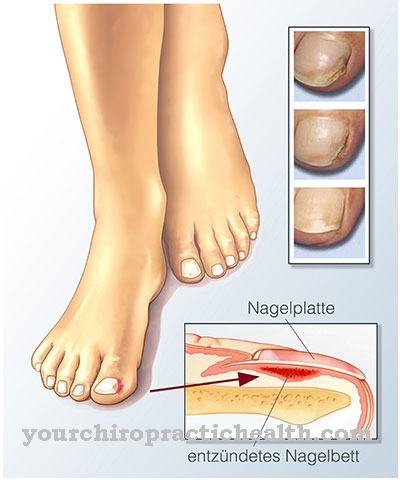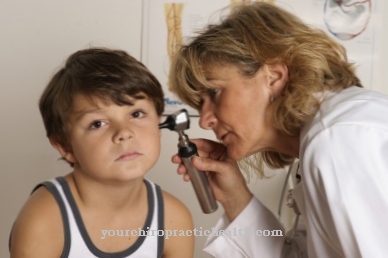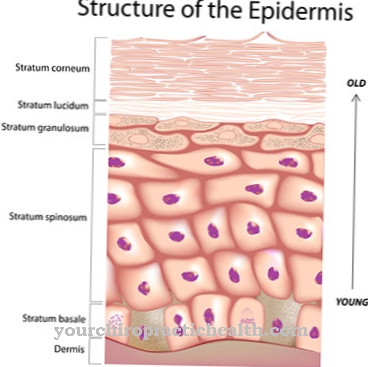Circular hair loss is not a dangerous disease. For those affected, however, it is always associated with a great psychological burden, since the bald spots usually appear on the head and are easily visible to outsiders.
What is circular hair loss?

Circular hair loss is the second most common form of hair loss. Mostly young people and children are affected. Statistically, men are more often affected than women.
Circular hair loss is not a serious illness, but it usually means an extremely high psychological burden for those affected. In around 50 percent of sufferers, the bald and mostly circular spots regress within two to three years.
In about ¼ of those affected, however, there is a total loss of all body hair. The circular hair loss often occurs in attacks. Hair loss can occur every three years. Circular hair loss is probably one of the autoimmune diseases.
causes
Circular hair loss probably belongs to the autoimmune diseases. Usually, the immune system is directed against bacteria or viruses entering the body. With an autoimmune disease, the immune system is directed against the body's own tissue.
In circular hair loss, the immune system classifies the hair follicles as foreign and attacks them in various places. This immune system reaction can occur in some areas of the scalp hair, but it can also affect the entire body. For example, circular hair loss can lead to partial or complete hair loss, which can also affect eyelashes, eyebrows, armpit and pubic hair.
It is assumed that circular hair loss is genetically determined, since a familial increase in circular hair loss can be observed.
Symptoms, ailments & signs
Circular hair loss shows itself through initially localized hair loss. The hair falls out in herds that are more or less circular. Alopecia areata occurs mainly in young people and has its highest incidence in people between 20 and 40 years of age.
In all those affected, the hair on the head is particularly affected. This can lead to individual hairless areas, or the disease progresses quickly and leads to total hair loss. If all head hair is lost, it is called alopecia areata totalis. If all other body hair is also lost, it is referred to as alopecia areata universalis.
In some cases, the hairless spots recede after a while. Spontaneous healing occurs. The hair on the edge of the dropout points can be pulled out more easily. The resulting stains can also be announced by so-called exclamation point hairs. This describes hair that becomes thinner towards the bottom - due to the attacked hair follicles.
Otherwise there are no physical symptoms. There is no scarring, no flaking and also no visible inflammatory reactions. However, circular hair loss can have a significant impact on the psyche of those affected. Women and young people in particular can suffer from loss of aesthetics.
Diagnosis & course
To consolidate the diagnosis at Circular hair loss the taking of the medical history (anamnesis) and various clinical examinations are necessary. As a rule, however, the disease can be identified based on its typical appearance.
Circular hair loss results in sharply defined and bald areas of the body, which often occur on the head. Another typical sign is ivory skin on the bald areas. When taking the anamnesis, the duration of the symptoms and any accompanying symptoms are of particular importance.
The clinical examination includes an examination of the quality and quantity of the hair. The hairline and hair follicles are also examined. This is primarily done through various laboratory tests using hair and hair follicle samples taken. In addition, the doctor will also examine the scalp. The strength of the hair anchorage can provide further information on diagnosing circular hair loss.
Complications
Circular hair loss is of course not a clinical picture, but in most cases a hereditary symptom. In extreme cases, such hair loss begins at the age of 30, so this appearance can also lead to various complications. Affected people often suffer less from the physical complaints than from the psychological problems.
For many affected people, early hair loss is a drastic experience. The psychological stress can increase so much that it can even lead to significant depression. However, physical complications can also arise if the affected person resorts to various hair restoring products.
Such hair restorers are very aggressive, which can lead to severe skin irritation on the scalp. If the skin becomes irritated or reddened, the product should be discontinued immediately. Otherwise it can become very itchy, so that an open wound can develop due to the constant scratching.
An open wound is generally very susceptible to inflammation, so that further complications can arise in this case. Thus, the following applies: With circular hair loss, various complications are possible, which should definitely be treated by a doctor. This is the only way to avoid permanent consequential damage.
When should you go to the doctor?
People who notice signs of circular hair loss should discuss the condition with a healthcare professional. A visit to the family doctor is particularly recommended in the case of severe hair loss that cannot be traced back to a clear cause. In the case of circular hair loss in one or more places, a medical examination is always useful. If the symptoms are not limited to the hair, but also affect eyelashes, eyebrows or body hair, it is best to go to a doctor's appointment in the same week. If symptoms such as burning, itching, or pain occur, the hair loss may be caused by a serious condition that needs further investigation.
Other unspecific accompanying symptoms should also be clarified by a doctor in any case. Inflammation, bleeding and crusting in the scalp area must be examined and treated with medication, otherwise major complications can arise. Serious infections may need antibiotic treatment. If you suffer from mental problems due to circular hair loss, it is best to seek therapeutic advice at an early stage. Otherwise, the mental suffering can become entrenched and cause long-term problems.
Treatment & Therapy
At the Circular hair loss From a medical point of view, no therapy is necessary in many cases. In half of the cases, the circular hair loss regresses on its own and there are only very few real health problems. However, since most of those affected suffer psychologically considerably from the symptoms, it must be decided on a case-by-case basis whether and from when treatment will be given.
If the circular hair loss is only weakly pronounced, therapy is usually refrained from, because in these cases there is often an improvement or healing of the symptoms within a few months. To support the healing process, zinc and solutions or ointments containing cortisone are administered. In some cases, local irritation therapy is also used. Dithranol is used for this, actually an active ingredient for the treatment of psoriasis.
In severe cases, external immunotherapy with the help of diphenylcyclopropenone is carried out. Sometimes PUVA therapy can also help. This is a treatment with UV-A rays. Unfortunately, there is no therapy available to cure the causes of circular hair loss. Every treatment approach is therefore only aimed at eliminating the symptoms that occur. However, none of the possible treatments can prevent the recurrence of circular hair loss.

You can find your medication here
➔ Medication for hair loss and baldnessOutlook & forecast
In the case of circular hair loss, the prognosis is good. The bald spots will heal on their own after a few weeks to months. Healing of the affected areas is to be expected even with protracted courses. The spontaneous hair regrowth usually occurs within three years. The alopecia areata, however, occurs in phases and is repeatedly noticeable as bald spots.
Without medical treatment, a chronic condition can develop, which can also lead to psychological complaints. Special forms such as alopecia universalis, alopecia totalis and ophiasis offer a poorer prognosis. A spontaneous healing of the bald spots is not to be expected with these forms, since a total loss of the head or body hair usually occurs. If the hair on the edges of the affected area is easy to pull out, the condition is likely to progress.
Medical treatment is necessary in any case in order to avoid physical and mental complications. In addition to the emotional consequences such as depressive moods and inferiority complexes, physical complaints such as itching or reddening can occur, which must be treated. Circular hair loss can significantly reduce the quality of life. As a rule, life expectancy is not affected, provided the alopecia areata is not caused by a serious condition.
prevention
Since the Circular hair loss is genetic, so far there are no effective measures to prevent it. When the symptoms first appear, an attempt can be made to prevent the hair loss from progressing by taking zinc. However, the opinions of experts differ in this regard. Some doctors are of the opinion that early treatment can hinder the body's own healing process and that circular hair loss heals better without treatment.
Aftercare
Circular hair loss does not require follow-up care as it is not a serious disease. Rather, there is an optical problem that can be acutely treated. Scheduled follow-up examinations, such as those performed after cancer, are designed to prevent recurrence.
To date, however, there is no known measure that could prevent circular hair loss. A dermatologist can therefore only repeatedly make the diagnosis and, if necessary, prescribe tablets or creams. Complications are not to be expected as a result of circular hair loss. Rapid spontaneous healing does not leave any lasting consequences.
However, if bald spots are permanently visible or occur again and again, this can lead to psychological suffering. Regular therapy may then be indicated to stabilize the personality. The psychotherapist goes into everyday problems and discusses how to solve them.
Whether and when circular hair loss heals cannot yet be determined scientifically. But this is an essential element for a targeted and forward-looking treatment. Children have a greater chance of spontaneous healing than adults. There is no early diagnosis, which is an essential element of follow-up care.
You can do that yourself
Various measures and home remedies can help with circular hair loss. Depending on the cause, hair loss can often be curbed by changing your lifestyle.
A healthy and balanced diet, for example, strengthens the immune system and can thus prevent hair loss. We recommend a diet rich in fiber, minerals and vitamins, which can be supplemented with zinc and calcium supplements in consultation with your doctor. Regular exercise, adequate sleep and avoidance of stress are also recommended. In addition to these general measures, a number of home remedies will help. Nettle or fern leaves have proven effective - both are combed into the hair in the form of an infusion. Equally effective is a hair conditioner made from dried rosemary, which is best used daily.
If the measures mentioned do not show any effect, a visit to your family doctor or dermatologist is recommended. Circular hair loss may be caused by a serious condition that needs to be treated first. Medical advice is also required in the case of natural causes, because medication can sometimes help against hair loss. In case of doubt, hair loss can be counteracted with the help of a hairpiece or a hair transplant.




.jpg)








.jpg)

.jpg)
.jpg)











.jpg)